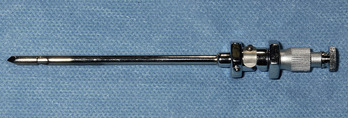CHAPTER 5. PERCUTANEOUS PLEURAL BIOPSY
Contraindications46
Equipment46
The Abrams’ needle47
Site of biopsy47
Practical procedure49
Post-procedure investigations50
Post-procedure care51
Cautions52
Complications52
Suggested reading52
Pleural biopsy, originally an open technique, has been more commonly performed blindly ever since Abrams’ description using a specialized needle in 1958. Prior to Abrams’ development, the original technique used a Franklin modification of the Vim-Silverman needle, which was used for renal biopsy. Despite Cope also describing a novel needle for pleural biopsy in 1958, the Abrams’ needle remains the most popular apparatus. Recently there has been interest in ultrasound-guided biopsies with both modified Abrams’ needles and needles that only require a single pass for multiple biopsies.
 Tip Box
Tip Box
Image guided cutting needle biopsies have a higher yield for malignancy than standard Abrams’ needle pleural biopsy.
(British Thoracic Society guidelines)
INTRODUCTION
Percutaneous pleural biopsy is occasionally performed when other means for reaching a diagnosis of an exudative pleural effusion have not been successful. Pleural aspirate examination coupled with cross-sectional imaging and cytology obtained at bronchoscopy will usually provide sufficient data to make a diagnosis. Percutaneous pleural biopsy is, however, recommended when standard cytology is non-diagnostic. The procedure is particularly useful when granulomatous or malignant disease of the pleura is suspected.
CONTRAINDICATIONS
• Coagulopathy.
• Local sepsis over biopsy site.
• Lack of consent.
EQUIPMENT
• Dressing pack.
• Sterile gown, gloves and drapes.
• Chlorhexidine cleaning solution.
• Lidocaine.
• 1 × 10 mL syringe.
• 1 × 20 mL syringe.
• Orange needle.
• Green needle.
• Skin pen
• Gauze.
• Scalpel.
• Clamped forceps (one for blunt dissection and one for chest drain insertion if required).
• If a chest drain is to be inserted post-biopsy: large-bore chest drain kit, connecting tubing, closed drainage system (with sterile water for underwater seal), suture (e.g. ‘1’ silk).
• Sterile dressing.
• 3 sterile specimen pots (for biochemistry, microscopy culture and sensitivity, cytology) and specimen pots for histology (containing formaldehyde solution).
• Abrams’ needle (Fig. 5.1).
 |
| Fig. 5.1 |
THE ABRAMS’ NEEDLE
The Abrams’ needle consists of three separate components (Fig. 5.2):
Buy Membership for Cardiovascular Category to continue reading. Learn more here


